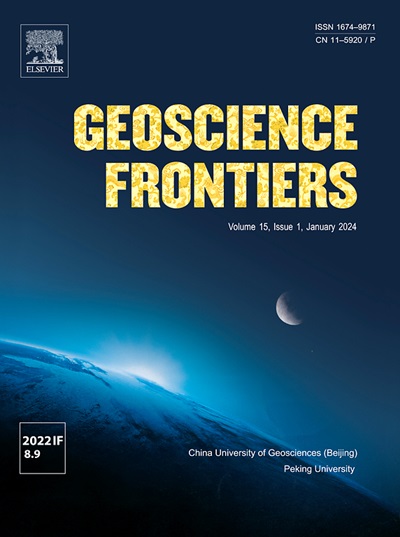兴蒙陆内造山带晚古生代构造、变形与地球动力学
IF 8.9
1区 地球科学
Q1 GEOSCIENCES, MULTIDISCIPLINARY
引用次数: 0
摘要
大陆内造山带的构造和地球动力学仍然是一个基本的地质挑战。兴蒙陆内造山带(XMIOB)叠加在中亚东部造山带(CAOB)上,为研究陆内造山带动力学提供了重要依据。然而,人们对其构造、变形模式和地球动力学过程知之甚少。本研究结合地质填图、构造分析、EBSD石英c轴结构、地震反射解释和锆石U-Pb年代学,揭示了XMIOB的构造演化,并将其与全球陆内造山带进行了比较。研究结果表明,XMIOB是由褶皱冲断带和变质带交替形成的,主要受原有伸展构造的反转控制。EBSD分析表明,地壳深处存在中温(400°C - 500°C)韧性变形,而地震剖面则突出了由dsamiclement带驱动的结构解耦。锆石Eu/Eu*比值的综合地壳厚度重建显示出三个构造阶段:晚石炭世—二叠纪软流圈上升流诱导地壳从~ 50 km减薄至~ 35 km,形成具有buchan型变质和双峰岩浆作用的岩石圈弱带;晚二叠世—中三叠世地幔俯冲引发挤压增厚(~ 55 km)、褶皱冲断带的形成和早期伸展断裂的构造反转,暴露出变质带;中三叠世以来,持续的地幔俯冲和深部地壳解耦作用推动了大规模的侧向挤压和右旋剪切作用,重塑了XMIOB构造。与全球陆内造山带的对比突出了陆内造山带演化的两个关键特征:造山前岩石圈变薄形成了继承的弱带,使后续变形局部化;继承的伸展特征决定了最终的构造,产生了变质带和褶皱冲断带的系统交替。本文章由计算机程序翻译,如有差异,请以英文原文为准。

Late Paleozoic architecture, deformation, and geodynamics of the Xing’an–Mongolia intracontinental orogenic belt
The architecture and geodynamics of intracontinental orogens remain a fundamental geological challenge. The Xing’an-Mongolia intracontinental orogenic belt (XMIOB), superimposed on the eastern Central Asian Orogenic Belt (CAOB), provides key insights into intracontinental orogenic belt dynamics. However, its architecture, deformation patterns, and geodynamic processes are poorly understood. This study integrates geological mapping, structural analysis, EBSD quartz c-axis fabrics, seismic reflection interpretation, and zircon U-Pb geochronology to unravel the XMIOB’s tectonic evolution and compare it with global intracontinental orogenic belts. Our findings reveal that the XMIOB is shaped by alternating fold-thrust belts and metamorphic zones, dominantly controlled by the inversion of pre-existing extensional structures. EBSD analysis indicates mid-temperature (400 °C – 500 °C) ductile deformation in the deep crust, while seismic profiles highlight structural decoupling driven by a décollement zone. Integrated crustal thickness reconstructions from zircon Eu/Eu* ratios delineate three tectonic stages: Late Carboniferous-Permian asthenospheric upwelling induced crustal thinning from ∼50 km to ∼35 km, forming lithospheric weak zones with Buchan-type metamorphism and bimodal magmatism; Late Permian-Middle Triassic mantle subduction triggered compressional thickening (∼55 km), fold-thrust belt formation, and tectonic inversion of early extensional faults, exposing metamorphic zones; from the Middle Triassic continued mantle subduction and deep-crustal decoupling drove large-scale lateral extrusion and dextral shear, reshaping the XMIOB architecture. Comparisons with global intracontinental orogenic belts highlight two key traits of intracontinental orogenic belt evolution: pre-orogenic lithospheric thinning generates inherited weak zones that localize subsequent deformation; inherited extensional features dictate the final architecture, producing the systematic alternation of metamorphic zones and fold–thrust belts.
求助全文
通过发布文献求助,成功后即可免费获取论文全文。
去求助
来源期刊

Geoscience frontiers
Earth and Planetary Sciences-General Earth and Planetary Sciences
CiteScore
17.80
自引率
3.40%
发文量
147
审稿时长
35 days
期刊介绍:
Geoscience Frontiers (GSF) is the Journal of China University of Geosciences (Beijing) and Peking University. It publishes peer-reviewed research articles and reviews in interdisciplinary fields of Earth and Planetary Sciences. GSF covers various research areas including petrology and geochemistry, lithospheric architecture and mantle dynamics, global tectonics, economic geology and fuel exploration, geophysics, stratigraphy and paleontology, environmental and engineering geology, astrogeology, and the nexus of resources-energy-emissions-climate under Sustainable Development Goals. The journal aims to bridge innovative, provocative, and challenging concepts and models in these fields, providing insights on correlations and evolution.
 求助内容:
求助内容: 应助结果提醒方式:
应助结果提醒方式:


